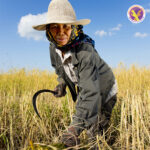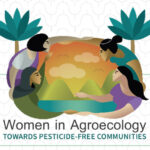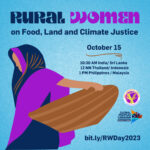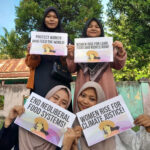STOP Endosulfan! Stop Pesticides Poisonings!
On the occasion of global “No Pesticides Use Day” this 3rd December 2008, Pesticide Action Network Asia and the Pacific (PAN AP) calls for the global ban and phase out of the production and use of Endosulfan, one of the most dangerous organochlorine pesticide in the world.
Endosulfan belongs to the group of highly toxic chemicals called persistent organic pollutants (POPs) and has already been banned in 56 countries because of its high toxicity and environmental contamination. However, its presence in Asia and the Pacific continues to acquire lives and damage natural resources.
This year alone, three major incidents highlight its adverse effects: in May, Endosulfan was found in lettuce, strawberries and courgettes in New Zealand, posing health risks to consumers and growers; in June, the ill-fated MV Princess of the Stars sank in the Philippines and was found to contain 10 metric tonnes of Endosulfan, threatening people’s health and the marine environment; in November, five students died in Ranchi, India, after drinking milk that had Endosulfan residues.
“It is truly alarming that in Asia and the Pacific, not only millions of workers and farmers are being affected by Endosulfan, but also consumers, marine ecosystems and even children are exposed and are suffering from health problems, poisoning, and even deaths!” says PAN AP Executive Director, Sarojeni V. Rengam. She adds, “It is an unmitigated tragedy that Endosulfan, Paraquat, and numerous other pesticides – which are extremely hazardous under conditions of use in the South – are still so widely used from Bangladesh to India, from Thailand to the Philippines, and Cambodia to China”.
In October 2008, the Review Committee of the Stockholm Convention met and concluded that Endosulfan met the criteria for inclusion in the treaty, but several countries exporting the pesticide including India, blocked its addition to the prior informed consent (PIC) during the Rotterdam Convention.
“Its turning up as residues in our daily food is completely unacceptable. It is an endocrine disruptor, mimicking oestrogen at very low levels of exposure and is implicated in breast cancer. It is also a neurotoxin and is linked to Parkinson’s disease, it causes birth defects, and it undermines the immune system.” says Dr. Meriel Watts of Pesticide Action Network Aotearoa. She adds, “Many hundreds of people have been killed, particularly in Africa and India, by exposure to this pesticide when used in agriculture. In New Zealand, ERMA is reassessing Endosulfan and we hope this will bring about a final ban on it but in the meantime, we call on growers to immediately stop the use of this highly toxic and destructive pesticide.”
In the Philippines, Endosulfan was banned in 1994 but two major pineapple plantations (Del Monte and Dole) somehow managed exemptions and were allowed to use it even after findings that Endosulfan applicators in Del Monte developed abnormalities in their chromosomes. The pineapple companies have been importing 10 metric tonnes of Endosulfan yearly. The ill-fated MV Princess of the Stars was found to be carrying the pesticide for the pineapple companies. “Its sinking posed a massive global environmental pollution.” says Dr. Romeo Quijano of the College of Medicine, University of the Philippines Manila. He explains, “A very slight amount of Endosulfan that would be dissolved in water is sufficient to kill fish and cause adverse health effects in animals and humans upon exposure. While the Philippine Pesticide Authority indicated that the pineapple companies’ license to use Endosulfan will no longer be renewed starting next year, they have not issued any order to recall any Endosulfan stocks still being held by the companies.”
“Moreover, residues of the deadly pesticide have been recently found in surface water and in vegetables in Mindanao, posing a major threat to consumers and growers. Although the provincial government of Bukidnon passed an ordinance banning the use of Endosulfan, this would only cover Del Monte and not Dole, whose use of Endosulfan is mainly in South Cotabato,” adds Quijano. He furthers, “It is also common knowledge that the pesticide continue to enter the country through its backdoor ports.”
In the latest incident in Ranchi district India, five students died from taking milk mixed with Endosulfan. While investigations on the milk poisoning case are still ongoing, Endosulfan continues to pose threats not only to milk consumers, as it is being used for sugarcane, tomato, brinjal, pulses and cashew. The incident reflects the extensive availability and use of the pesticide, and this is not surprising as India is one of the major exporters of Endosulfan. India was also one of the countries who blocked the inclusion of the pesticide into the Prior Informed Consent (PIC) Procedure for Certain Hazardous Chemicals and Pesticides during the recently concluded Fourth Conference of the Parties (COP-4) of the Rotterdam Convention.
The PIC Convention demands that recipient countries in trade interactions are aware of and accept the dangers associated with the specific and listed chemicals they import. Currently, 39 chemicals are listed as requiring the prior informed consent (PIC) procedure. The conference sought to add three more chemicals to the list, as recommended by its subsidiary scientific body. However, only tributyltin compounds (TBT) was listed – with parties failing to agree applying the PIC procedure to chrysotile asbestos and Endosulfan. The two latter chemicals are still in active use, and major exporters strongly opposed their listing under the PIC procedure, fearing this would hamper their trade – even though the PIC procedure by no means bans trade as such. The fate of the two chemicals will be taken up at the next COP.
“The exclusion of Endosulfan and chrysotile asbestos blatantly shows that the pesticide industry and their profit motives have tragically succeeded over the safety of consumers and workers, and have powerfully influenced the credibility of the Rotterdam Convention,” asserts Rengam. She adds, “We have to continue to expose our legitimate concerns and scientific evidences especially with the current trend of globalisation and increasing commercialisation of agriculture that promotes intensive use of hazardous pesticides.”
On 3rd December 2008, activities to draw attention to the life threatening impacts of chemical pesticides such as Endosulfan, on people and the environment will be taking place across Asia and the Pacific. For additional information, please visit www.panap.net
“No Pesticide Use Day” is in commemoration of the thousands who died, and the tens of thousands who still suffer as a result of the 1984 Bhopal disaster. The tragedy of Bhopal has been called the worst commercial industrial disaster in history – but not the last. Around the world the ongoing manufacture, distribution, and use of chemical pesticides continue to seek devastating impacts on people and the environment. The World Health Organisation estimates that yearly, at least 3 million people are poisoned and 200,000 die by using pesticide. While many of the reported ill effects constitute acute cases of pesticide poisoning, it is the chronic long-term effects such as cancers that are of increasing concern.
# # #
Contact: Clara Guzman
PAN Asia and the Pacific
P.O. Box 1170, 10850, Penang, Malaysia
Contact Number: +604 657 0271 or +604 656 0381
Email: panap@panap.net







